Japan Street Fashion 3 High Schoolers
Japanese street fashion refers to a number of styles of contemporary modern clothing in Nihon. Created from a mix of both local and foreign manner brands, Japanese street fashions tend to have their ain distinctive manner, with some considered to be extreme and avant-garde, with similarities to the haute couture styles seen on European catwalks.
Though extremely popular in the 1990s and early 2000s, many trends experienced a levelling off in the afterwards 2000s and onwards; the rise and autumn of many of these trends had been chronicled by Shoichi Aoki since 1997 in the fashion magazine Fruits, which was a notable magazine for the promotion of street fashion in Nippon.[i]
History [edit]
In 2003, Japanese hip-hop, which had long been present amid clandestine Tokyo's club scene, influenced the mainstream style industry.[2] The popularity of the music was and then influential that Tokyo'south youth imitated their favorite hip hop stars from the way they dress with oversized dress to tanned pare.[3]
Modern Japanese street fashion [edit]
Though the styles accept changed over the years, street manner is yet prominent in Tokyo today. Immature adults tin oftentimes exist found wearing subculture attire in large urban fashion districts such every bit Harajuku (Ura-Harajuku), Aoyama, Ginza, Odaiba, Shinjuku and Shibuya.
Lolita [edit]
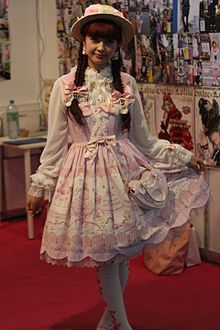
Containing many dissimilar themes within its boundaries, Lolita has become one of the larger, more recognizable styles in Japanese street mode and has gained a following worldwide. Skirts or dresses are usually worn at or below knee length with petticoats below for volume. Blouses or tops are lace-trimmed or ruffled in the Victorian or Rococo style. The length of the socks or stockings can go from ankle to thigh level and may be topped with lace. Wearers of this fashion manner often put on Mary Janes or boots. The more well-known sub-styles within Lolita mode are as follows:
- Gothic Lolita - Lolita with a heavy influence from the Eastern and Victorian Goth mode. Often characterized past dark colors, and accessories adorned with motifs such as skeletons, bats, spiders and other popular gothic 'icons', such as characters from Tim Burton films. Victorian iron gates and architectural designs are also often seen in dress prints. Bonnets, rectangle headdresses and brooches are popular accessories for Gothic Lolita.
- Sugariness Lolita - the most childlike style, mostly characterized by baby animals, fairy tale themes and innocent, childlike attire. It was originally inspired past Victorian children'due south clothing and the kawaii culture that is very prevalent in Japan. Pastel colors are oft used, although some dresses or skirts may feature darker or muted colors equally well. Large caput bows, cute purses and stuffed animals are pop accessories for Sweetness Lolita.
- Classic Lolita - a sub-mode more than closely resembling the historical fashion of the Rococo or Victorian eras. The colors that are used in this wait are usually muted, thus giving this sub-style a more mature experience. Floral prints and solid colors are common, although fancier prints are not unheard of likewise. Small head bows, bonnets, rectangle headdresses and hair corsages are popular accessories for Archetype Lolita.
- Punk Lolita - an experimental manner, mixing the influences of Punk with Lolita. It can sometimes look deconstructed or crazy, while keeping most of the 'Lolita silhouette'.
- Ouji - also known every bit 'boy mode', are the more masculine counterparts of lolita, influenced by Victorian boys' vesture. 'Prince pants', which are brusk capri-manner pants that are cut off the human knee, usually with some sort of detail (such as lace-edged cuffs) are commonly worn with masculine blouses, top hats, knee socks and other accessories.[4]
Gyaru [edit]
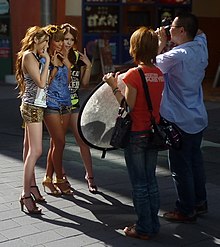
Gyaru being photographed in Ikebukuro in 2009
Gyaru (sometimes known as Ganguro , actually a subcategory of gyaru ), is a type of Japanese street manner that originated in the 1970s. Gyaru focuses on girly-glam style, dwelling on man-fabricated dazzler, such as wigs, imitation lashes and fake nails. Gyaru is as well heavily inspired by Western manner.
Ganguro [edit]
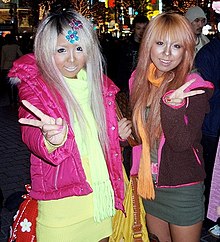
Two ganguro girls in Tokyo, April 2008
The Ganguro style of Japanese street way became pop amongst Japanese girls in the early 1990s and peaked in the early 2000s. Ganguro falls into the larger subculture of gyaru mode. Ganguro typically includes brightly colored outfits, mini-skirts, and tie-dyed sarongs. The ganguro style consists of bleached hair, a deep tan, false eyelashes, black and white eyeliner, bracelets, earrings, rings, necklaces and platform shoes.
Many people consider Namie Amuro to have been the leading figure of ganguro style. Exactly subsequently her public appearances with tanned skin and dyed hair, a lot of Japanese girls started to follow her example. The terms "Yamanba" and "Manba" refer to the extreme ends of the Ganguro way. However, enthusiasts of both the Yamanba and Manba styles consider ganguro as an "easy version" of their style. Present, the name 'Yamanba' has shortened to 'Manba' . [v]
Kogal [edit]
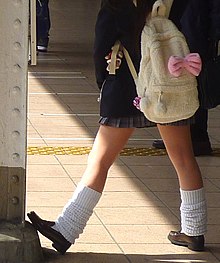
A kogal identified by her loose socks and shortened brim
The Kogal ( Kogyaru ) look is based on a high schoolhouse compatible, but with a shorter brim, loose socks, and often dyed hair and a scarf likewise. Members of the Kogal style sometimes refer to themselves equally Gyaru (gals). This manner was prominent in the 1990s, and it started gaining its popularity once again since the end of 2020.
Bōsōzoku [edit]
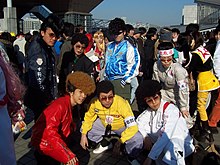
Japanese cosplayers dressed up in bōsōzoku -style outfits
While bōsōzoku fashion has not been widely popular since the 1990s, the stereotypical Bōsōzoku look is often portrayed, and fifty-fifty caricatured, in many forms of Japanese media such equally anime, manga and films. The typical bōsōzoku member is often depicted in a compatible consisting of a jumpsuit like those worn past manual laborers or a tokko-fuku ( 特攻服 ), a type of war machine issued over-coat with kanji slogans. These are normally worn open up, with no shirt underneath, showing off bandaged torsos and matching amorphous pants tucked within alpine boots.
Decora [edit]
The Decora mode originated in the late 1990s/early on 2000s and rose to great popularity both in and exterior Nippon. It is exemplified by vocalist Kyary Pamyu Pamyu, who rose to prominence in the Harajuku fashion scene before her musical debut. The wearers usually stick to color palettes for their decora, examples including Pink Decora, Red Decora, Night Decora, and Rainbow Decora. A plain shirt and hoodie were often worn with short tutu-like skirts. The pilus (often worn in depression ponytails with long bangs) and make-upward itself tend to be quite plain. Yet, the about pregnant function of Decora is to pile on many layers of cute accessories until the bangs and front end hair are barely visible. Stockings, legwarmers, arm warmers, and knee joint socks are also worn over each other in dissimilar layers. Common details likewise include leopard prints and patterned dental masks. The style has since decreased in popularity simply still has a big following worldwide.
Visual Kei [edit]

Visual Kei is a style created in the mid-1980s by Japanese musicians consisting of hit makeup, unusual hair styles and flamboyant costumes, similar to Western glam rock and glam metal. Androgyny is as well a popular aspect of the style. Some of the more than well-known and influential artists of the manner include X Japan, Luna Sea, Versailles, The Gazette, Mejibray, Royz, L'Arc en Ciel, An Cafe, Malice Mizer, and Diaura.
[edit]
Oshare Kei is the contrary side of Visual Kei , with bright colors and many popular impressions. This said, bands under this style alive upward to the meaning by dressing up in colorful costumes, or in Decora or Pop Kei fashion; many are seen sporting massive amounts of jewelry and numberless of cartoon characters and animals slung on, many colorful hairclips, and lighter make-up. The music is more happy sounding, the lyrics lighter and happier. Bands include An Cafe, Panic Channel, Ichigo69, Lolita23q, SuG, Delacroix, LM.C, and Aicle.[6]
Angura Kei [edit]
Angura Kei is a nighttime Japanese style that is often associated with a subgenre of Visual Kei . The term derives from the Japanese pronunciation of "underground", which refers to its origins in underground theater. The clothes tend to exist heavily influenced by traditional Japanese elements besides as the Showa era (1926-1989) but with a Goth spin to it. The make-up unremarkably consists of shironuri , and is dark and heavy. While kimono are the most common used by visual kei artist, the style also ofttimes features modified japanese schoolhouse uniforms. Motifs and accessories are themed around post-war Japan and the occult.
Cult Party Kei [edit]
Cult Political party Kei , named after the Harajuku store Cult Political party (now known as the Virgin Mary), is a mode that was popular around the early 2010s and is based on Western religious artifacts similar crosses or bibles. Common aspects include crosses wired in yarn, layers of fabric in soft colors, lots of cream lace, satin bows and bible prints. The brand-upward and hairstyle is non as over the pinnacle every bit other styles. Cult Political party Kei is frequently worn with natural looking make-up without any larger emphasis on the eyes and simple hair-dos with roses. Cult Party Kei is considered past some to be a subset of Dolly Kei .
Dolly Kei [edit]
Dolly Kei is a style based on Japan's view of the Middle Ages and European fairy tales, especially the Brothers Grimm and Hans Christian Andersen. It includes a lot of vintage-mode habiliment and sometimes has religious symbols. Grimoire is a store in Japan that has been described equally "the pioneering store behind the Dolly- kei fashion scene".[7]
Fairy Kei [edit]
Fairy Kei is a artless style based on 1980s fashion. Outfits are made upwardly of pastel colors, angels, toys and generally cute motifs and elements and accessories from Western toy lines of the 1980s and early 1990s, such every bit Polly Pocket, My Piddling Pony, Strawberry Shortcake, Rainbow Brite, Popples, Lady Lovely Locks, Barbie, Wuzzles, and Care Bears. Pastel-colored hair is common, although natural hair is likewise popular, and hairstyles are ordinarily kept uncomplicated and decorated with anything beautiful or pastel; bows are a mutual theme. The term "Fairy Kei " originated from the magazine chosen Attachment (despite common belief that Sayuri Tabuchi [Tavuchi], the owner of Tokyo fashion shop Spank!, was the accidental creator of the mode).[eight]
Mori Kei [edit]
Mori Kei ( mori meaning "forest") uses soft, loosely fitting layers of garments such equally floaty dresses and cardigans. It places an accent on natural fabrics (cotton, linen, wool) and manus-fabricated or vintage accessories with a nature theme. The colour scheme tends to exist light and neutral, but patterns such as gingham and florals may also exist used. In terms of hairstyles, bangs (oft curled) and braids are very popular. The manner is like to Dolly Kei in that the aim is to create a doll-like advent, but in a more than casual, bawdy way.[9]
Peeps [edit]
Peeps is a 90s inspired sporty goth fashion that has been popularized in Harajuku's hugger-mugger scene past the online mag PEEPS. It was voted one of the major trends for 2020 in the yearly tendency forecast by the japanese women's magazine Mery.[x]
Kimono Mode [edit]
Despite the widespread nature of Western clothing in Japan, Japanese fashion is still influenced past traditional clothing, with people yet wearing the kimono in daily life, though most people wearable it but for weddings, graduations and other formal occasions.
Despite the heavily-reduced numbers of people wearing kimono equally everyday clothing, the younger generation in Japan can still be seen to mix kimono and mod style in fashion, wearing modernistic footwear and accessories instead of the typical geta and kanzashi unremarkably worn. There are even modernistic designers who accept used the kimono as inspiration, such equally the "TANZEN" collection from designer Issey Miyake.[ citation needed ]
Fashion industry and popular brands [edit]

Although Japanese street way is known for its mix-match of different styles and genres, and at that place is no single sought-after brand that can consistently appeal to all fashion groups, the huge demand created past the way-witting population is fed and supported past Japan's vibrant way industry. Issey Miyake, Yohji Yamamoto and Comme des Garçons are oftentimes said to be the three cornerstone brands of Japanese fashion. Together they were particularly recognized as a Japanese style force in the early on 1980s for their intensive apply of monochrome color and cutting-edge design.
As early as the 1950s, there were a few brands peculiarly catered to street fashion, such equally Onitsuka Tiger (now known as the ASICS).
Nippon is also known for its meaning consumption of strange luxury brands. According to information from 2006, Japan consumed 41 percent of the unabridged globe's luxury goods.[xi] The blue line of Burberry is amongst the most successful in this loonshit.
International influence [edit]
Japanese street manner influences the West Declension of the United States.[12] High-end style brands similar Comme des Garçons have played a big role in the global industry since the 1980s, particularly through frequent cross-over guest design with other brands. In 2008, Rei Kawakubo designed for Louis Vuitton[13] and H&Thou.[14]
Tomoko Yamanaka's work was featured at London Manner Calendar week, 2010.[15]
Harajuku Fashion was ranked 5th in the fashion field of Google Search of the Year in 2019.[sixteen]
[edit]
The social motives driving interaction with and involvement in personal fashion choices and wider style movements within Japan are complex.
Firstly, the insufficiently large quantity of disposable income available to Japanese youth is meaning; many fence this has been, historically, made possible through a greater degree of Japanese youth living at home with their parents for much longer than in other countries, reducing living expenses and thus making larger spending on clothing possible.[17]
In addition, the emergence of strong youth culture in the 1960s and 1970s that continues today (especially in Harajuku, a district in Shibuya, Tokyo, Nihon.) drives much of the development of new styles, looks, and fashion subcultures. The ascent of consumerism, which played an of import part in Nippon's "national character" during its economic smash in the 1980s, continues to influence fashion purchases, even after this economic bubble outburst in the 1990s. These factors event in the swift turnover and variability in styles pop at any one time.[18]
Encounter also [edit]
- 2000s in Japanese fashion
- 2010s in Asian fashion
- Youth civilisation
- Campsite (manner)
- Fruits (magazine)
- Cuteness in Japanese culture
- Madam/Aristocrat
- Elegant Gothic Aristocrat
- Neo-Victorian
- Cosplay
- Visual Kei
- Poupee Girl
- Babe the stars shine brilliant
References [edit]
- ^ "Fruits: future-pop fashion". Dazed. 2016-01-12. Retrieved 2019-07-28 .
- ^ Takatsuki, Yo (2003-12-17). "Japan grows its own hip-hop". BBC News.
- ^ Condry, Ian. Hip-hop Japan: Rap and the Paths of Cultural Globalization. Durham, NC: Duke University Press, 2006.
- ^ "Kodona". Archived from the original on 2012-03-17.
- ^ DIGIMBAYEVA, ANELIYA (August iii, 2018). "Japanese Street Fashion". STREETWEARCHICK. Retrieved April nine, 2020.
- ^ "Oshare Kei". JaME-Globe.com. xviii April 2010.
- ^ "Grimoire Shibuya - Japanese Dolly-kei & Vintage Manner Wonderland". Tokyofashion.com. 2010-03-13. Retrieved 2011-12-xi .
- ^ McInnes, Paul. "Spank! – Japanese "80s Popular Disco" Fashion in Tokyo". tokyofashion.com. tokyofashion.com. Retrieved 28 March 2012.
- ^ SHOJI, KAORI (February viii, 2010). "Cult of the Living Doll in Tokyo". NY Times . Retrieved March 30, 2012.
- ^ "Harajuku Pop - 今話題のピープス女子って何?! かわいくかっこよくなれる注目新ジャンルを徹底調査". 2 August 2020.
- ^ Japan External Merchandise Organization| Japan is the world'due south most concentrated source of revenue for luxury brands Archived 2009-03-02 at the Wayback Motorcar
- ^ "Fashion Sensei". 19 July 2013.
- ^ "FARFETCH - the Global Destination for Modern Luxury".
- ^ "Comme des Garcons for H&M".
- ^ "Designer profile : Cabinet by Tomoko Yamanaka". London Fashion Week. 2011-09-21. Retrieved 2011-12-11 .
- ^ "Harajuku Fashion was ranked 5th in the fashion field of Google Search of the Year in 2019". Jan 4, 2020. Retrieved fourteen January 2020.
- ^ Letter from Tokyo: Shopping Rebellion – What the kids want
- ^ Godoy, Tiffany (December 2007). Vartanian, Ivan (ed.). Style Arrears Disorder: Harajuku Street Fashion Tokyo. San Francisco: Relate Books LLC. ISBN9780811857963 . Retrieved 14 March 2018.
PDF on kingdom-visions.com, readable online with a gratis account
External links [edit]
- Kobe Collection
- Tokyo Girls Drove
- Tokyo mode.com
- Style arena
- Fashion Press
0 Response to "Japan Street Fashion 3 High Schoolers"
Post a Comment